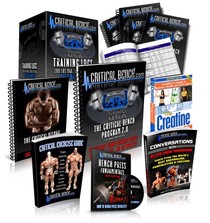
Bench Press Techniques For Powerlifting
Bench pressing more weight is a major goal of just about any guy who weight trains. Whether you're a serious powerlifter or just a normal gym rat, increasing your bench press max is likely something you strive for. However, a huge bench press won't come overnight. It takes time for most people to get up to a 300 or 400 pound bench press. Fortunately, there are some bench press techniques you can take advantage of to raise your max.
One of the best bench press techniques is to perform the exercise the right way to lift more weight. While you will see many people cheat like crazy to bench more weight, you'll also see lifters who appear to be benching with perfect form but aren't getting as much as they could out of the exercise. For instance, many lifters believe that the best way to bench press is to keep the back completely flat against the bench. However, when you do this you are doing yourself a great disservice. You will actually be training your chest more efficiently if you pull your shoulder blades inward while you perform the bench press. Using this bench press technique will pop your pecs out and target them better. When you keep the upper back perfectly flat you're going to working your front deltoids and possibly your triceps more than you need to. You should also keep a natural arch in your lower back when benching and never raise your behind off of the bench.
Performing forced reps and negative only reps are both excellent bench press techniques. When you're doing a bench press set have a spotter assist you with an extra forced rep or 2 to add some intensity to your workout. You could even try benching a weight that is just a little bit heavier than you can lift and have a spotter assist you throughout the entire rep. Negative only reps will require a spotter on each side of the barbell since you are basically doing only the negative part of the bench press. To do them you take a weight too heavy for you to bench and lower it slowly to your chest. When the weight gets to your chest the spotters help you lift it up. You need to lower the weight slowly and with complete control for safety and effectiveness when you do negative only reps. Both of these bench press techniques are useful for getting a feel for heavier weights when you're trying to increase your max.
Another great bench press technique is to identify where you have the most trouble during a bench press rep and doing sets targeting just that part of a rep. Many lifters are weakest at the point of a bench press rep when they first start lifting the weight off of their chests. If this is true for you, you can do bench press sets where you only lift the weight a few inches off of your chest. The best way to do this is to set up in a rack that will allow you to place stoppers a few inches above you when you're benching. When you do a rep, hold the weight against the stoppers for a couple of seconds before lowering it. If you have trouble locking out, you can use the same bench press technique in a different way. In this case you would set the stopppers so that you lower the weight to them and do only the last few inches of a rep. Soon, you'll find that you are stronger at your weakest point in a bench press rep and you should be able to handle more weight.
If you take advantage of these great bench press techniques you will succeed at increasing your bench max. You can find more great benching techniques at Critical Workout review.